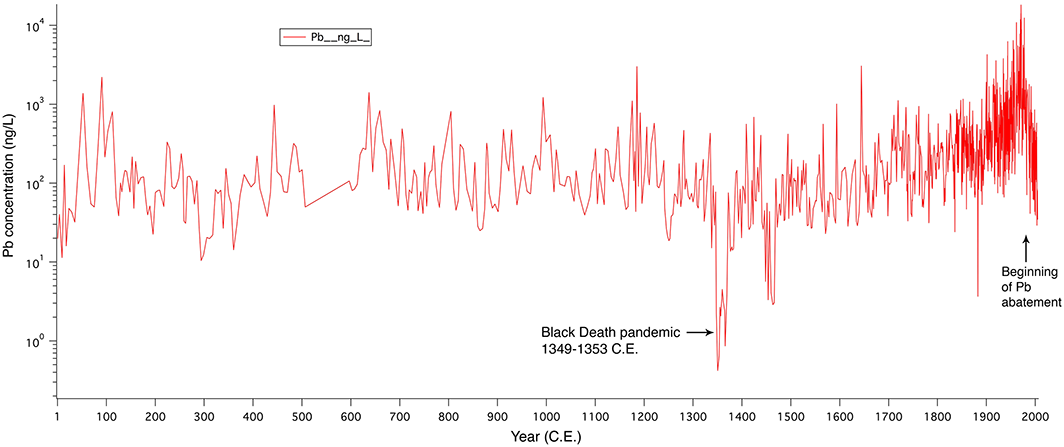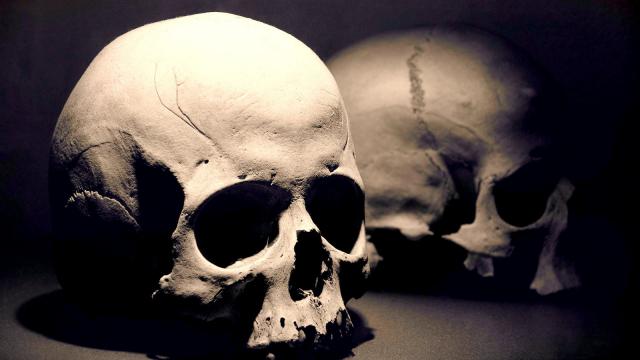From 1347 to 1351, a nightmare disease ravaged Europe, afflicting victims with putrid black boils, fevers, vomiting, and in short order, death. Daily life ground to a halt as the Black Death spread along medieval trade routes, claiming an estimated 20 million lives with ruthless efficiency. Now, a team of researchers is asserting that the plague had an unexpected impact: Clearing the air of a toxic pollutant for the first time in over a thousand years.
Image: er madx/Flickr Creative Commons
Lead pollution is typically considered a hallmark of industrial society, but a growing body of research suggests human activity has been fouling the air with harmful heavy metals for millennia. Results of a new ice core analysis, published last week in the journal GeoHealth, support the idea that in Western Europe at least, mining and smelting activity has tainted the air with lead for at least 2000 years. In fact, the only sliver of time during which the scientists’ instruments sniffed lead-free air was from 1349 to 1353, when folks were presumably too busy dying in droves to work the mines.
“With the closing of the mines, you can see the levels of lead dropping to zero,” Alexander More, a historian of science at Harvard University and lead author on the new study, told Gizmodo. “We can go down to the month of the arrival of the plague, and you can see the immediate drop, right along mining activity.”
More and his colleagues say their findings have implications for health and environmental policy today, suggesting that “natural background” levels of lead — as seen during plague years — are quite close to zero. But other experts contacted by Gizmodo were sceptical of that claim, saying more data is needed to confirm that air pollution plummeted during the plague, and that the reason was an abatement of industrial activity.
These researchers certainly aren’t the first to point out that pre-industrial societies were fouling the air with lead, which was used for winemaking, pipes and coinage in the Roman empire, stained glass windows and rooftops in medieval Europe, and silver smelting in colonial South America. Alpine sediment lake records from Spain even indicate high levels of lead pollution caused by metallurgy during the Bronze Age, some 4000 years ago.
But the new analysis offers one of the highest-resolution snapshots of atmospheric lead levels to date, which, coupled with an extensive analysis of historical records, appears to tell a compelling story. Working at the Climate Change Institute’s Laser Ice Facility at the University of Maine, the researchers used high-resolution mass spectrometry and laser ablation techniques to measure lead concentrations in the upper portion of 72m-long ice core, extracted from the Colle Gnifetti glacier in the Swiss-Italian Alps. The ice core, whose layers preserve an environmental record from the time they were first packed down, allowed the researchers to see how much lead was in European air centuries ago, down to the level of individual years.
Not surprisingly, the researchers found that lead levels rose steadily in the early 1800s, coinciding with the onset of the Industrial revolution. Prior to that, atmospheric lead varied substantially, but almost never fell near zero. Except, for a brief period, after the plague struck. Corroboration with historical records indicated a dramatic decrease in mining activity upwind of the ice core site during plague years, particularly in medieval Britain.

Reconstruction of atmospheric lead concentrations from a Swiss Alpine ice core over the past 2000 years. Image: More et al. 201
“Our historical perspective shows that we’ve always been smelting lead, and the levels [in the air] have been elevated,” More said. “And then, we saw, in the period of time when 50% of the Eurasian population died because of a pandemic, the levels of lead dropped to zero.”
This interpretation suggests that pre-industrial levels of lead, which are used as a baseline for forming air quality standards, are not as free of human influence as we thought. “We assume that anything before 1800 doesn’t matter, there was no industry and no pollution,” More said. “That’s not true. We’ve been exploiting nature and polluting the air for the past 2000 years, with consequences we still have to discover.”
Indeed, a large body of research shows that even small levels of lead exposure in air, water or soil can have harmful impacts on everything from fertility to early childhood development. The US Centres for Disease Control says no levels of blood lead are safe for children, and that even low levels can have an impact on IQ. The researchers believe that tying pre-industrial lead pollution to human activity could bolster the case for tightening air quality standards even further.
But not everyone is convinced of the authors’ interpretation. Paolo Gabrelli, a paleoclimatologist at the Byrd Polar and Climate Research Center at Ohio State University, told Gizmodo he found the results interesting, but cautioned that they need to be corroborated with data from other ice cores in the same region.
“Independent studies using different Alpine cores need to be performed,” Gabrelli said. “In fact, the reproducibility of small features as observed in ice core records (e.g. Black Death drop in lead around 1349-1353 CE) is not always obvious even when the analysis are performed on multiple ice cores extracted from the very same drilling site.”
Margit Schwikowski, a chemist at the Paul Scherrer Institute who has done research on other Colle Gnifetti ice cores, told Gizmodo the results didn’t surprise him. “We have known about pre-industrial Pb emissions even during Greek and Roman times,” he said. But he also felt the study’s attribution of a decline in lead pollution to the Black Death was “very speculative,” due to uncertainties in dating ice core layers, and noted that mineral dust might be contributing to some of the lead signal, as well.
Others were enthusiastic about the new study’s conclusions. Gonzalo Jimenez Moreno, a paleoclimatologist at the University of Granada, felt that the research aligned with an emerging picture. “The study shows something that has been observed in other sediment records from Europe — the air has been polluted with lead for thousands of years,” he told Gizmodo. Celia Sapart, a paleoclimatologist at the Universite Libre de Bruxelles, told Gizmodo she has observed “similar patterns for other compounds such as methane.”
“They did not use our data in their paper, but it would definitely support strongly their interpretation and I am even surprised on how similar our profiles are,” she told Gizmodo, referencing a paper on historic methane pollution her research team published in 2012. Sapart praised the new study for its “very solid and high quality dataset”.
Reconstructing the past is a messy business, and the debate over how much our ancestors sullied the air — and the extent to which catastrophic events like the Black Death cleared it — is likely to rage on for years. But if one thing’s clear, it’s that we need to stop thinking of the pre-industrial past as a pollution-free era. Humans have always impacted their environment, and we’re just starting to come to terms with the consequences.
